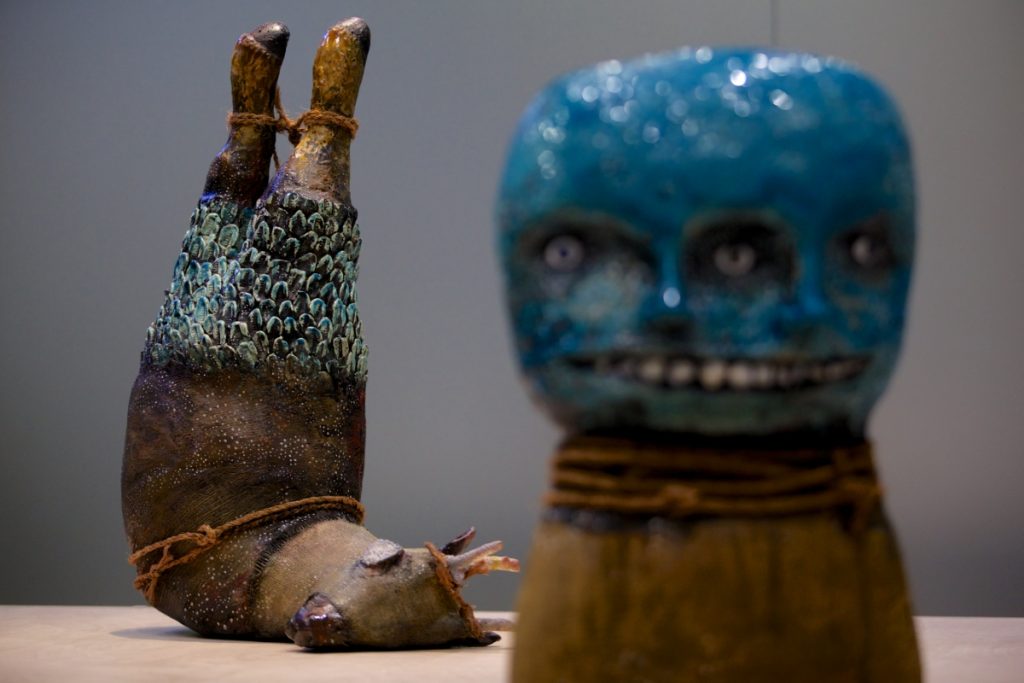
Foreground: Bogeyman, 2018. Installation view of Kerry Jameson’s The Contingent at Marsden Woo Gallery. 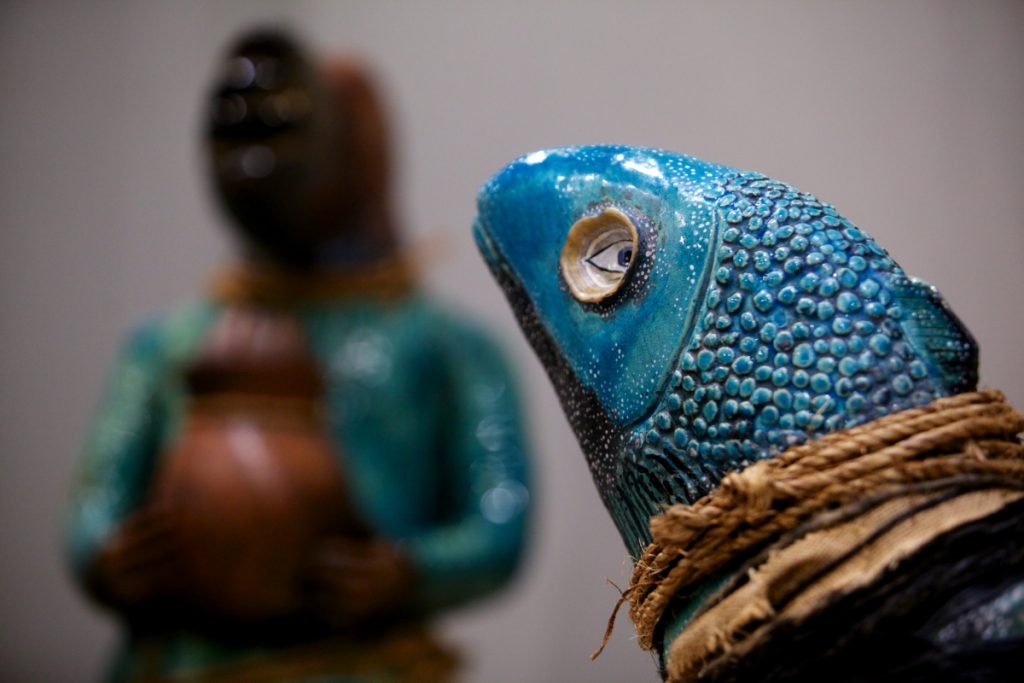
Foreground: Fish Tied, 2018. Installation view of Kerry Jameson’s The Contingent at Marsden Woo Gallery. 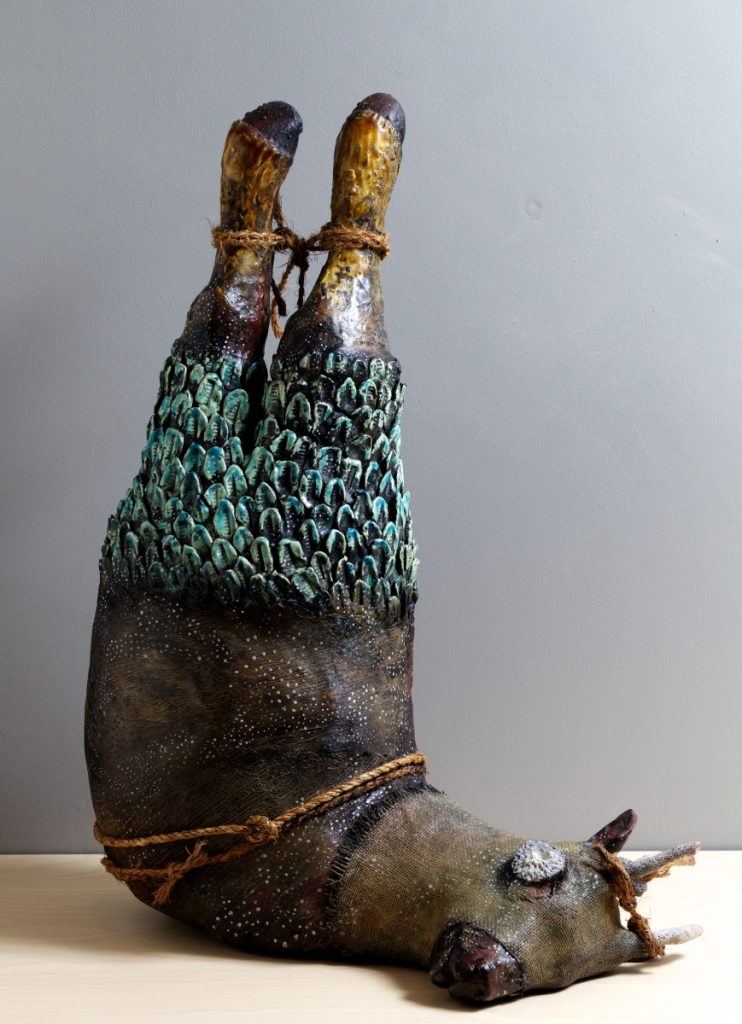
Coral Rope Bambi, 2018 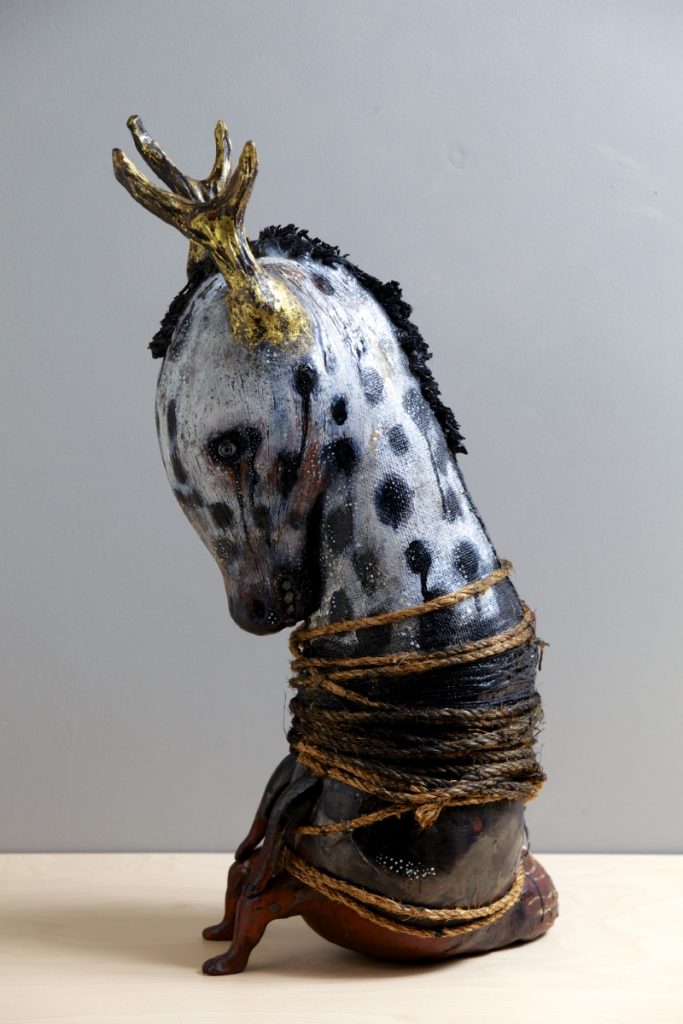
Kerry Jameson, The horse with antlers 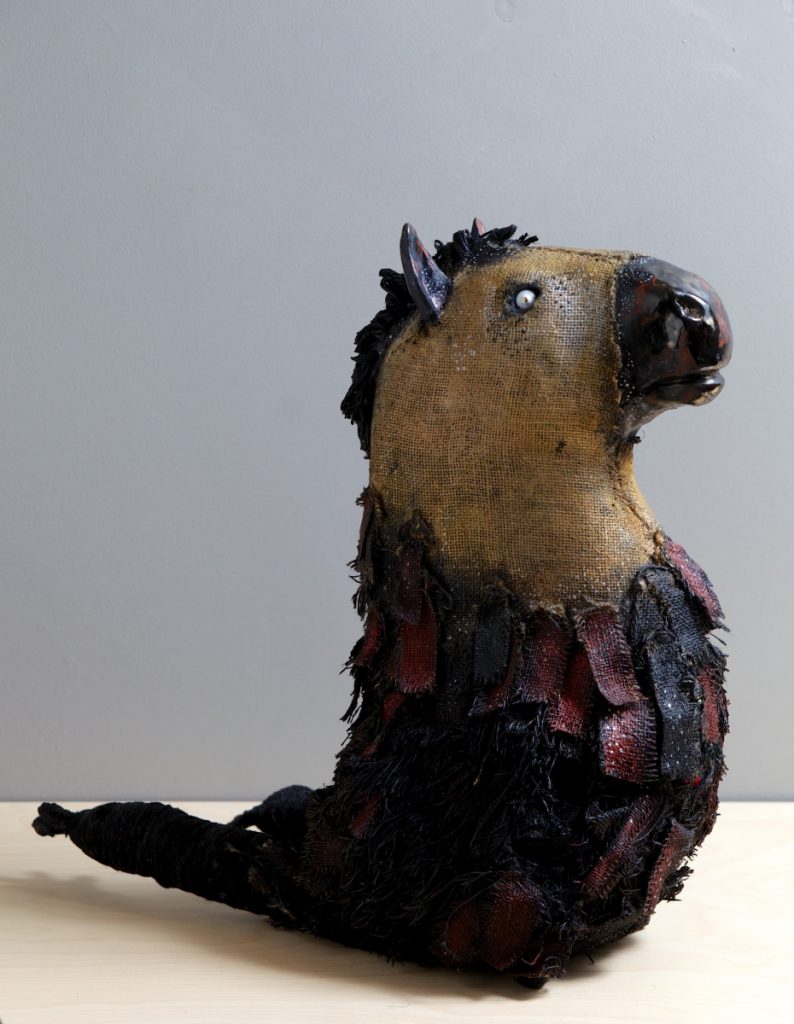
Horse and Hands, 2018 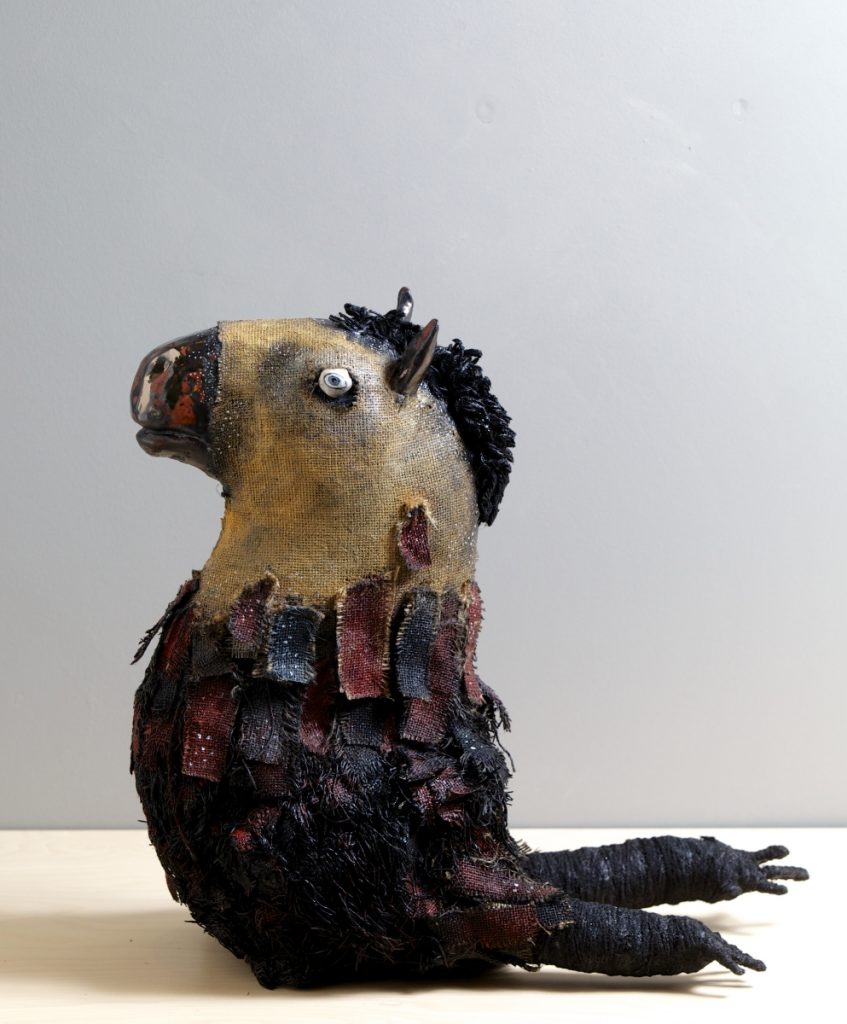
Horse and Hands, 2018
Kerry Jameson: The contingent, 2018-2019
Resolve and resolution, October 2018
All nine of the substantial works in Kerry Jameson’s show at Marsden Woo, London, were made between May and August in 2018. The pieces are given urgency by the short time in which they were constructed.
The tallest, Shell Warrior, stands scary and beautiful on four incense burner legs. Feathered shoulders initially intended for an owl hold up the battle helmet, and fix in place the yellow hooves of a donkey. Turquoise glaze runs around the raised clay surface. While top-heavy, and standing at 30 inches, the totemic figure has nonetheless achieved the resolution sought by ceramicists. But it has done so from a pile of ‘liberated fragments’. Picasso famously said that every act of creation comes from an act of destruction. Jameson’s work takes acts of destruction to an extreme.
She makes a work but even as it stands at the verge of completion, it dissatisfies her. She takes a hammer to it. Some of the fragments undergo a work of editing and recombining; rejected pieces go up on the shelf. This is an act of creation since, she says, ‘every fractured or discarded piece provides an opening and from this new situations are invented’. Breaking creates a moment in which the ‘medium is freed from its static nature’ to give it new opportunities and new life. It provides a tension in the studio that she needs in order to create.
But it is also a method involving crisis, for what is it like to see a pile of broken parts on the floor and be faced with a show deadline? First there are the fragments and then the mutations, which require immense resolve to ‘pull the work back together’. The ensuing battle ‘stretches the work emotionally’, something the viewer is likely to recognise and internalise. Help in meeting the crisis comes from traditions that ‘embrace repair such as the Japanese art of Kintsugi which treats breakage and mending as part of the history of an object, rather that something to disguise’.
Several factors bring the nine pieces together. One is place – all were made in Singapore. There must at least be some adjustment in turning the face towards the east. A second unifying theme is the local palm rope used on several pieces. On Pandora’s Jar it is tied around neck and waist and around the neck of the jar. In Bogeyman, it says ‘I will murder’. In Horse with Antlers, as well as appearing around neck and torso, it also binds the little Aztec-like figurine to the pot that stands for hindquarters. In the Western context it would suggest bondage but here it also connotes function, repair, repetition itself, and ornament. Another unifying element across the show is colour – from the green turquoise paint that Jameson took from an Aztec ornament, whose vibes tend to be otherworldly, alien, cool; from the warm gold of honey glaze, as on the donkey hooves; and from the darkest brown glaze that suggests a dirty surface. Antlers coated in gold leaf flash up brilliance.
Jameson called the show ‘The Contingent’. Some of this is to do with mechanics. In Horse with Antlers, the head presses down on the chest not as a sought-after gesture, but because the head needed to press on the torso to provide stability. Likewise, Jameson reached its thick donkey tail down from the shelf because balance called for it. Another kind of contingency comes from the sources she came across. The vessel in Pandora’s Jar comes from a delicate glass reliquary seen in St Caroleus Borromeus church in Amsterdam. Signifying sanctity, it is remote from the earthy jar and its large nut, fruit of Cerbera odollam, an eastern tree associated with suicide. The prompt for Bogeyman, a horrible three eyed creature, came from a pew-end in Amsterdam’s Oude Kerk. Paradoxically the contingent is what brings the show together.
Over the years Jameson has taken her method of breaking and recombining to what feels like crisis point: an extreme in technical possibilities, and an extreme in emotional force. Fish Tied for example started from a turquoise fish laid as it were on the slab, like some commodity. Jameson broke it and preserved the head which was eventually combined with legs from somewhere else, and feathered thighs from a never-used owl. The pieces are joined by palm rope, which also ties waist to limbs. The legs have to be sat on a table edge, so that the fish head becomes upright and thus acquires human connotations. The resultant image reworks the agonizing pain, physical and emotional, of the Laocoon. What we are seeing could be the reworking of a fable of identity – a transformation of Hans Christian Anderson’s Little Mermaid, who could only acquire legs at the cost of excruciating pain. Or is it something else? That you cannot put names to these hybrids contributes to their scariness.
All these sizeable pieces were created in the wake of serious illness and record an investigation of identity that has been draining. What is Coral, Rope Bambi? – this thing that does not signify death exactly yet has its donkeyhooves in the air? Robbed is robbed, but of what and by whom? The piece is somehow horrific, there is emptiness where there should be eloquence. It is muted like the maimed and tongueless Lavinia in Shakespeare’s Timon of Athens. Why does the figure of Pandora’s Jar have copper-green arms etched with dark veins? What name can we put to SHE? Maybe this show will prove an act of exorcism.
While most pieces break new ground, one points to Jameson’s starting point. Horse and Hands depends on a pair of ‘hands’ from the shelf. Attached to the rear and pointing backwards, they give it stability. But the torso is feathered as it were with scraps of hessian affixed with cement. This fabric – that can be found elsewhere binding and mending – is a reminder of The Sacred Made Real, London’s National Gallery’s 2010 exhibition of Spanish polychrome religious sculpture, statues that consisted of a wooden core clad in real fabric. This show provided Jameson with a crucial lesson – that the ceramicist does not have to stay with the purity of the medium.
Text by Lucy Gent
Photos © Philip Sayer, courtesy of Marsden Woo Gallery.
Photo captions
- Shell Warrior, 2018, Mixed media – Red and white, earthenware, porcelain teeth, acrylic, hessian, wax and shells. (Anthony Shaw Collection York Art Gallery). 32 x 34 x 76 cm
- Coral Rope Bambi, 2018, Mixed media: Red and white earthenware, palm rope, hessian, coral, acrylic, wool and wax. Private collection, 62 x 50 x 27 cm
- Pandora’s Jar, 2018, Mixed media – Red earthenware, acrylic, hessian, wax, Palm rope and seed, (Private collection), 33 x 27 x 76 cm
- The horse with antlers, 2018, Mixed media: Red earthenware, hessian, glass eyes, shell, stone chips, wool, palm rope, hessian twine, acrylic, wax and gold leaf, (Private collection). 57 x 28 x 22 cm
- Horse and Hands, 2018, Mixed media: Red earthenware, hessian, wool, hemp twine, porcelain teapot lid, shell, wire, acrylic and wax, (Anthony Shaw Collection York Art Gallery). 45 x 46 x 22 cm
- Foreground: Fish Tied, 2018, Mixed media: Red and white earthenware, palm rope, acrylic, wool, shells and wax. 64 x 37 x 34 cm. Installation view of Kerry Jameson’s The Contingent at Marsden Woo Gallery.
- Bogeyman, 2018, Mixed media: Red and white earthenware, acrylic, wax, hessian, palm rope, shell, glass eyes, (Anthony Shaw Collection York Art Gallery). 48 x 30 x 25 cm.
- Boody Hog, 2019, Reclaimed earthenware and raku ceramic. Shells, hemp rope, acrylic paint and beeswax, 53 x 33 x 24 cm


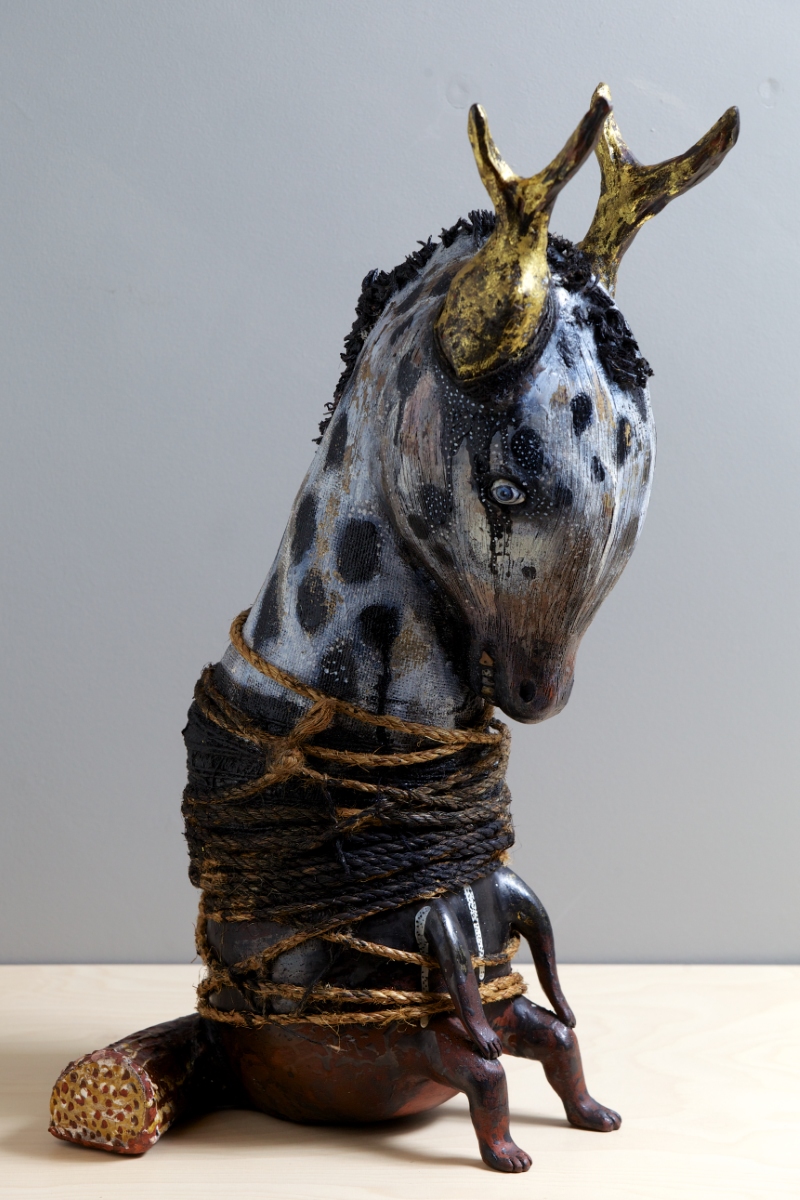
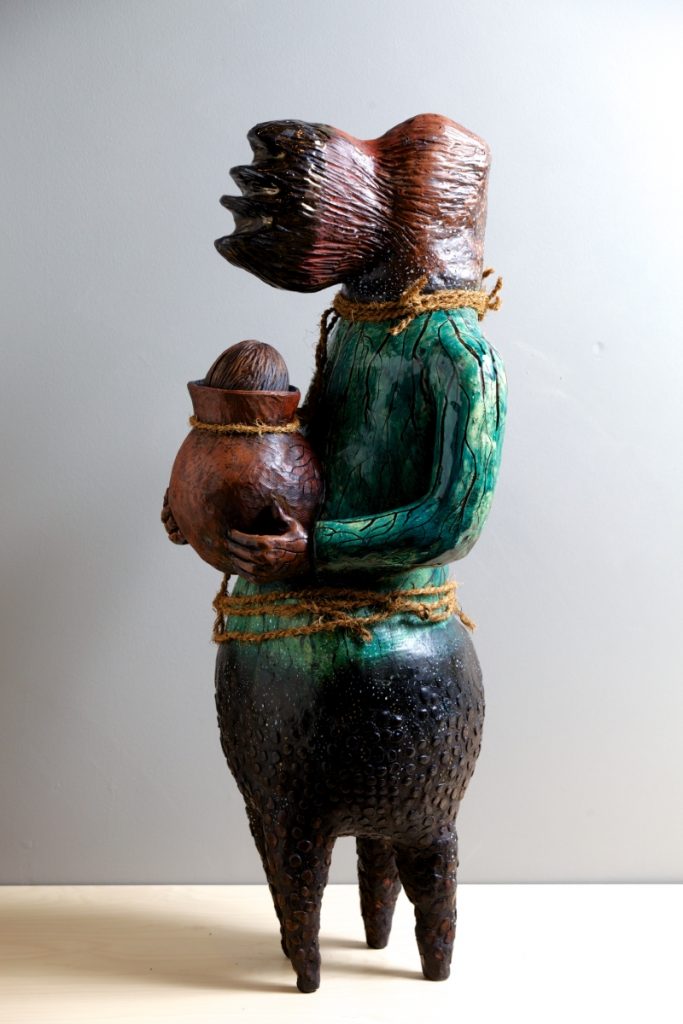
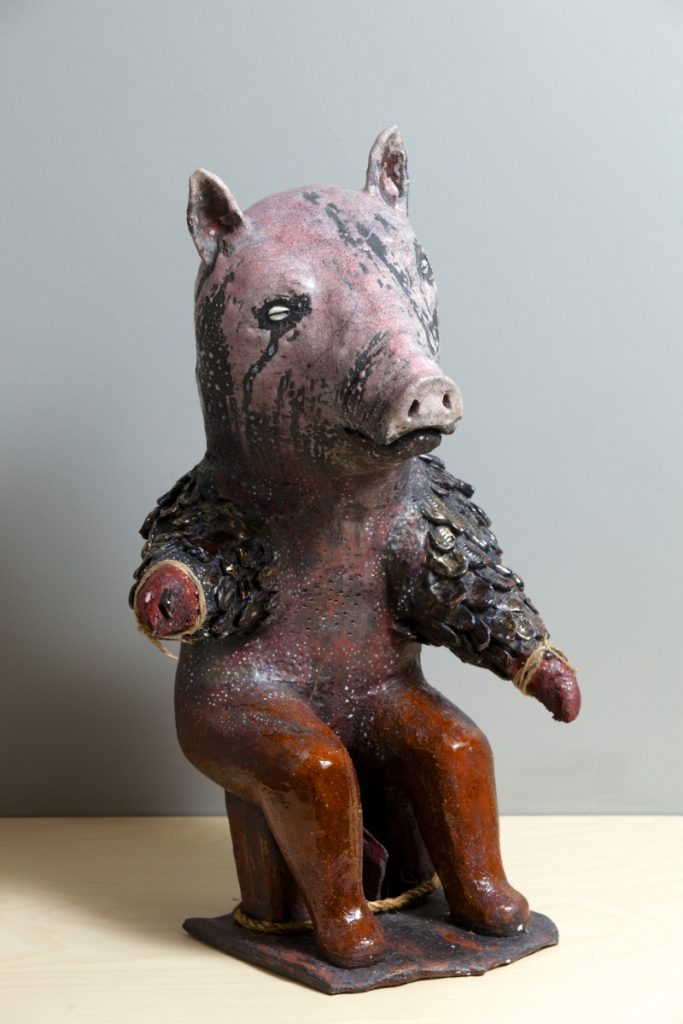
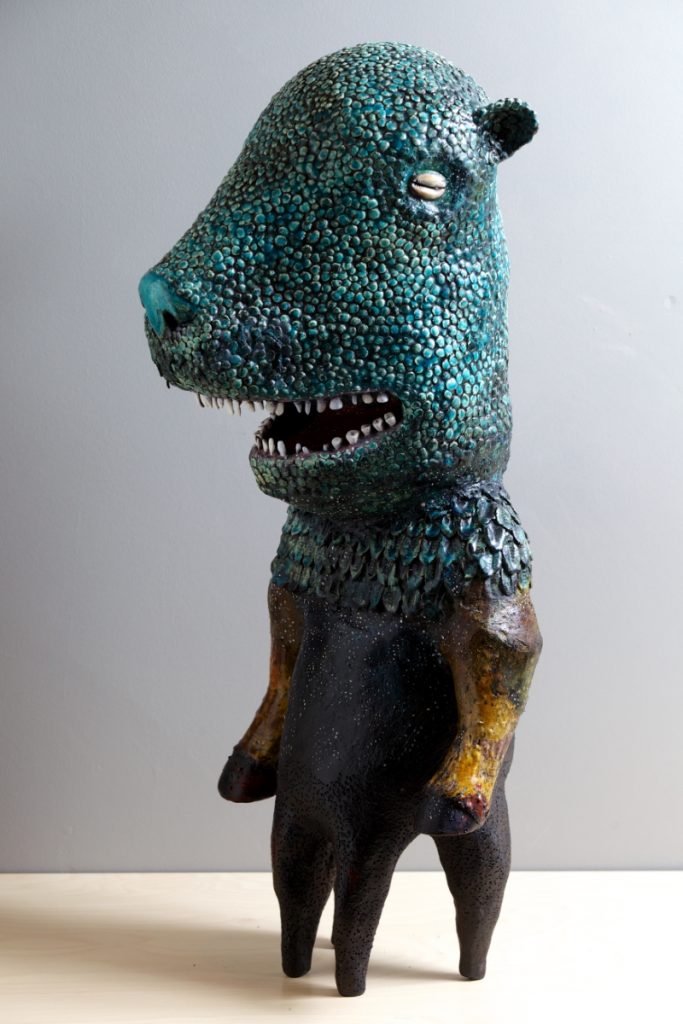


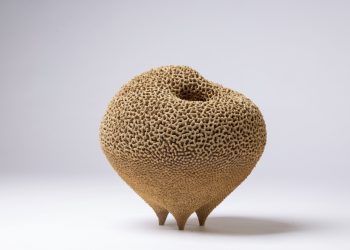













I have been looking for Kerry Jameson’s new work for some time and am so happy to have found this. I have thought, from the moment I first saw her work and met her that she is an inspirational and inspired artist. These images are spectacular and challenging. And oh how I would like to see them in the 3 dimensional world. I have some if her early work and feel privileged to look at it everyday. I hope that there is more even newer work and I’ll keep looking for it.
On personal note Kerry keep on keeping on, some of us here think of you often. Long May you continue to create these wonders of yours. Marian Anderson